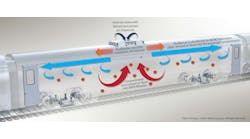Denver RTD explains airflow in its commuter rail trains
The Regional Transportation District (RTD) of Denver, Colo., has had its commuter rail trains in operation since 2016, connecting travelers between Denver’s Union Station and destinations farther away from the central core of Denver RTD’s system.
The 66 commuter rail cars in rotation that travel along Denver RTD’s four commuter rail lines also must meet stringent regulations put forth by the Federal Railroad Administration (FRA) and submit to crashworthiness testing, which places 400 tons of force onto each empty vehicle to check for the strength that was designed into the frame and structure and ensure that travelers inside would remain safe.
But what about the air? Amid a pandemic, it’s natural to wonder about air quality in enclosed spaces, as well as how the air inside each 85-foot vehicle is cleaned and circulated.
The heating, ventilation and air conditioning (HVAC) system exchanges the air within each rail car about every four minutes – or 15 times per hour – with the doors closed, an estimate determined by a vehicle engineer. Additional fresh air is introduced into the passenger compartment each time a commuter rail train stops at a station and the doors open.
Each car includes two HVAC rooftop units that run independently of each other if one fails. With both rooftop units running, 3,800-cubic feet per minute of air is supplied to each car, 29 percent of which is fresh, 71 percent recirculated. This air is supplied using overhead ducts and registers that run the length of the car. It is returned to each unit in the ceiling near the passenger doors on each end.
The HVAC system maintains passenger comfort by managing air temperature and humidity inside each car within specified ranges. Each car uses floor, underseat and door threshold heaters in the winter and during layover conditions to maintain a minimum air temperature inside the car.
Air is filtered using two, four-inch pleated filters for the return air and two, two-inch pleated filters for the fresh air, both carrying a minimum efficiency reporting value (MERV) rating of eight. Such filters trap particles down to three microns in size, including dust mites, pollen and mold.
Joe Phillips, Denver RTD’s manager of commuter rail vehicles who oversees this work, joined the district last year from Denver Transit Partners (DTP), the consortium of private companies that operates and maintains three of Denver RTD’s commuter rail lines: the University of Colorado A Line, the B Line and the G Line. DTP is responsible for maintaining all the commuter rail cars, which are moved around in pairs and can be placed on any of the lines as needed.
Phillips says the trains are safe not only because of their design, but because they are inspected every night by a qualified maintenance person and cleaned by a contractor using the same methods used on other Denver RTD vehicles to ensure passenger safety. With Denver RTD’s commuter rail trains being self-propelled passenger units, they must meet strict federal safety standards for both locomotives and passenger cars.
During daily inspections, Phillips said, qualified maintenance personnel are looking for faults. If an HVAC fault light came on, they would further inspect the HVAC system to determine what caused the fault light and whether it can be repaired before the next day. If that train cannot be repaired, it is set aside, and a new train takes its place.
“They are not allowed to send a train out of the building with any fault lights on it, per FRA regulations,” Phillips said.
The HVAC system is on a list of items to be inspected in full on every two-car train every 92 days, a time frame established by the FRA. Each inspection introduces more items to be inspected, per federal regulations. Regulations also take into account manufacturer recommendations. Any changes made to vehicles outside of federal regulations must be approved by a configuration control board.
An example illustrating this point is the air filters themselves, which are now changed every 92 days. When commuter rail was introduced to the Denver metro region in 2016, the manufacturer of the HVAC system told the vehicle manufacturer that the filters should be changed every 30 days.
“We were changing them with that frequency, and there was nothing bad about them,” Phillips said. “You could see that they were relatively new.”
A configuration control board does not have to approve a different frequency at which the air filters are changed – that falls to the manufacturer of the HVAC system, with the understanding that if a fault were to be shown because of wear and tear during the longer time frame, it would return to changing the filters more frequently. But the board would have had to grant its approval had a different type of filter been considered. This approach applies to all components on Denver RTD’s commuter rail cars, Phillips said.
With 25 years of experience in the railroad industry, Phillips wants people to understand the safety considerations that drive every aspect of how rail cars are manufactured and operated. He knows them “top to bottom, front to back, inside and out,” having started his career as a welder on passenger rail cars, designed aspects of passenger rail and consulted with railroads before joining Denver Transit Partners.
“The general public, anybody who rides those vehicles and operators need to understand that they are extremely safe,” Phillips said. “I don’t think a lot of them know or think about that.”


